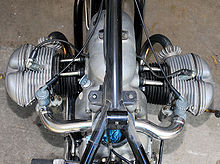Air cooling

Air cooling is a method of dissipating heat. It works by making the object to be cooled have a larger surface area or have an increased flow of air over its surface, or both. An example of the former is to add cooling fins to the surface of the object, either by making them integral or by attaching them tightly to the object's surface (to ensure efficient heat transfer). In the case of the latter it is done by using a fan blowing air into or onto the object one wants to cool. The addition of fins to a heat sink increases its total surface area, resulting in greater cooling effectiveness.
In all cases, the air has to be cooler than the object or surface from which it is expected to remove heat. This is due to the second law of thermodynamics, which states that heat will only move spontaneously from a hot reservoir (the heat sink) to a cold reservoir (the air).
Examples

Vehicles
Air is mainly used for air-cooled internal combustion engines (ICE), particularly those powering aircraft, because it is a readily available fluid and is often at a suitable temperature to be used efficiently. While many such ICE are called "liquid cooled" the cooling liquid is usually cooled by air passing through a radiator or heat exchanger. Examples of direct air cooling in modern automobiles are rare. The most common example is the flat engine or Boxer engine, once used extensively by Porsche and still in use on BMW motorcycles. Notable past models include the Volkswagen Beetle and related models, the Citroën 2CV, the Chevrolet Corvair and the Porsche 911 until 1998.
Turbines
Gas turbine engines (e.g. turbojets, turbofans, etc.) incorporate turbines, which are exposed to the hot gases exiting the combustion chamber. Where necessary, relatively cold air is bled from the compression system and used to cool the turbine blades and vanes, to prevent them from melting.
Electronics
Its use is widespread in computers and CPU cooling, where the computer processors produce large quantities of heat that, if not dissipated, could damage the CPU and other electronic components. In this case air has the advantage of being a good insulator too. However, in the future, new processors might generate too much heat to be dissipated through direct air cooling and it would follow that such direct cooling for computers and their components will become obsolete. Water cooling is somewhat popular in very high-power situations, such as large servers or heavily overclocked amateur systems.
Industries
A very large number of industrial processes use air as a cooling medium, either directly or indirectly. Air conditioning is a very common process in which the air in a room, or a whole building, is cooled in order to maintain a comfortable environment for its occupants. Often the air has been cooled by chilled water or brine and the heat transferred to that medium is transported outside the building where, often, fan-driven water-to-air heat exchanging is again effected to reject the heat into the atmosphere. A common sight around, for example, power stations are the large waisted concrete towers that emit steam more or less constantly. These are, in part, using air cooling on a grand scale.
Derating at high altitude
When operating in an environment with lower air pressure like high altitude or airplane cabins. The cooling capacity has to be derated compared to that of sea level.
A rule-of-thumb formula 1 - (h/17500) = derating factor. Where h is the height over sea level in meters. And the result is the factor that should be multiplied with the cooling capacity in [W] to get the cooling capacity at the specified height over sea level.[1]
See also
- Computer cooling
- Computer fan
- Evaporative cooling
- Water cooling
- Oil cooling
- Heat pipe cooling
- Peltier cooling
- Heater core
References
- ^ ericsson.net - Forced air cooling of DC/DC power modules at high altitude, Design Note 025 table "Cooling efficiency"
- Biermann, A.E. (1941). "The design of fins for air-cooled cylinders" (pdf). Report Nº 726. NACA.
- P V Lamarque, "The design of cooling fins for Motorcycle Engines", Report of the Automobile Research Committee, Institution of Automobile Engineers Magazine, March 1943 issue, and also in "The Institution of Automobile Engineers Proceedings, Session 1942-1943, pp 99-134 and 309-312.
- Julius Mackerle, "Air-Cooled Motor Engines". Charles Griffin & Company Ltd., London 1972
- Anish Gokhale et al.: "Optimization of Engine Cooling through Conjugate Heat Transfer Simulation and Analysis of Fins"; SAE Paper 2012-32-0054
